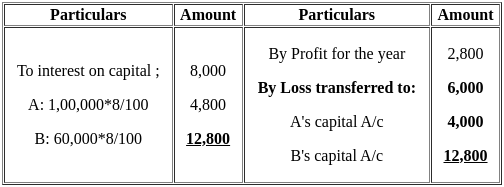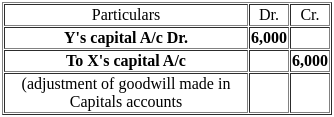Accountancy: CUET Mock Test - 3 - CUET MCQ
30 Questions MCQ Test CUET Mock Test Series - Accountancy: CUET Mock Test - 3
Preference shares, in case the holders of these have a right to convert preference shares into equity shares at their option according to the issue, such shares are called
A partner introduced additional capital of Rs 30,000 and advanced a loan of Rs 40,000 to the firm at the beginning of the year. partner will receive year's interest:
Aman and Bimal are equal partners in a firm. Aman drew regularly Rs. 1,000 at the end of every month. The year is ended on 31st March every year. Calculate interest on drawings @ 6% p.a.
Net Capital Employed is equal to :
(A) Fixed Assets + Current Assets - Long term liabilities
(B) Non current Assets + Current Assets - Current liabilities
(C) Fixed Assets + Current Assets - Equity
(D) Equity + Debt
(E) Current Assets - Current liabilities
Choose the correct answer from the options given below:
If the purchase consideration is more than net worth, then which account will be debited for the difference amount?
A company allotted 20,000 shares to applicants of 50,000 shares after rejecting 10,000 applications. The ratio in which company allotted the share will be
Which shareholders have a right to receive the arrears of dividend from future profits?
If applicants for 80,000 shares were allotted 60,000 shares on pro rata basis, the shareholder who was allotted 1,200 shares must have applied for
If the premium on forfeited shares has already been received, then securities premium account should be
Following amounts were payable on issue of shares by a company: ₹ 3 on application, ₹ 3 on allotment, ₹ 2 on first call and ₹ 2 on final call. X holding 500 shares paid only application and allotment money whereas Y holding 400 shares did not pay final call. Amount of calls-in-arrear will be
When full nominal (face) value of a share is called by the company, but as some shareholders did not pay the money on due date, their shares are being forfeited by the company. How the share capital is shown in the balance sheet (notes to accounts) of a company?
Minimum subscription should be 95% of the issued capital.
The % associated with preference shares as prefix (e.g., 10% Preference Share)s is the rate of ______
A company forfeited 3,000 shares of ₹10 each (which were issued at par) held by Kishore for non-payment of allotment money of ₹ 5 per share. The called up value per share was ₹ 8. On forfeiture, the amount debited to share capital
Mithas Limited was formed with share capital of ₹ 50,00,000 divided into 50,000 shares of ₹ 100 each. 9,000 shares were issued to the vendor as fully paid for purchase consideration of a furniture acquired. 30,000 shares were allotted in payment of cash on which ₹ 70 per share was called and paid. State the amount of subscribed capital.
A company issued 10,000 shares of ₹ 10 each at par; ₹ 3 on application; ₹ 3 on allotment; ₹ 4 on first and final call. One shareholder holding 1,000 shares paid the entire amount of his shares with application. Calculate amount received on application.
Pro-rata allotment is made in case of under subscription.
Actual num ber of shares offered to the public for subscription is known as _____
Zee Ltd issued 15,000 equity shares of ₹ 20 each at a premium of ₹ 5 payable ₹ 5 on application, ₹ 10 on allotment (including premium) and the balance on first and final call. The company received applications for 22,500 shares and allotment was made pro rata. Bittoo to whom 1,200 shares were allotted, failed to pay the amount due on allotment. All his shares were forfeited after the call was made. The forfeited shares were reissued to Dheeraj at par. Assuming that no other bank transactions took place, the bank balance of the company after the above transactions is
These shares which in addition to the fixed preference dividend, carry a right to participate in the surplus profits, if any, after dividend at a stipulated rate has been paid to the equity shareholders are called
Pragya Ltd. forfeited 8,000 equity shares of ₹ 100 each issued at a premium of 10% for non-payment of first and final call of ₹ 30 per share. The maximum amount of discount at which these shares can be reissued will be
Securities premium can be used to buy back its own shares by the company.
The liability of every shareholder of the company is unlimited.
|
8 docs|148 tests
|

















